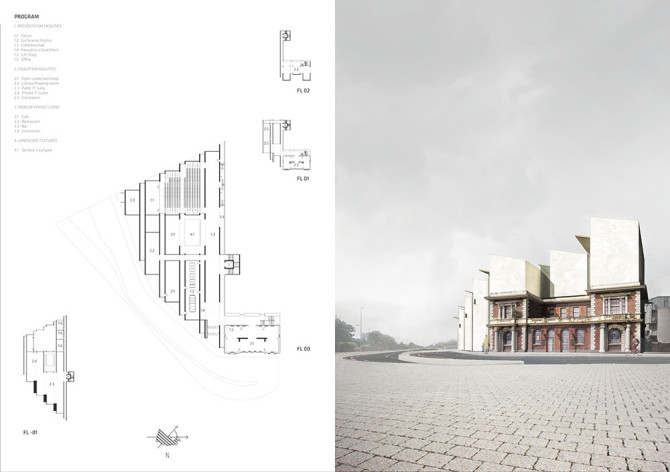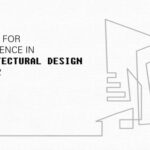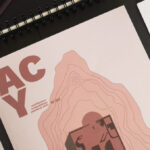One of the more interesting outcomes of an architectural competition lies in the prospect of imagination, to speculate both the fathomable and spectacular. The competition for a London Internet Museum stages such prospect, considering what seems at first rather tenable — the museum — merged with something historically profound and typologically unprecedented — the internet. The relationship is dichotomous: the museum historically posed to objectify and celebrate cultural and physical artifact, and the internet, a technological horizon perhaps as profound as fire and electricity, fueled by information and algorithm and existing almost entirely in the abstract.
The internet as a technology, has arguably occupied various typological precedents and forms: from the car garage where the internet startup was born, the ubiquitous cartesian data center, suburban office park campus, of historical renovations where the Googles, Facebooks, and Ubers call home, to the glass Apple stores and modern monuments to consumerism. As one might expect therefore, submissions to the competition varied quite dramatically. Many of the entries tended toward technological positivism, idealizing the internet without precaution. The jury showed preference to projects not bound by precedent or assumption — of conventional museum typologies, generalizations of what the internet is and isn’t, and contemporary architectural tropes. Selected projects demonstrate a certain tenacity and ambition, inherent in the internet’s advent — of social collectivism, network theory, and virtuality. While retrospective as a museum, submissions collectively project various architectural and tectonic trajectories, following the internet’s historic wake.
1st prize
SHAUN MCCALLUM & ALEKSANDRA BELITSKAJA, UK
404:NOT FOUND is distinguished by its resistance to authorial architecture and in its acceptance of the logic of the crowd. The project looks at architecture as an assemblage of crowd-sourced processes rather than the singular vision of a top-down designer. Architecture becomes an act of empowerment and an experiment for the participant, creating a platform and ethos of collaboration that legitimizes and enacts the desires of the user.
The user-defined building block is the generator of the architecture. In an app-based process of form-assign-upload-share, the block is propagated, manipulated, and multiplied, creating a rich aggregation of heterogeneous textures, materials, and spaces. 404:NOT FOUND favors the glitch, the mismatch, and the transgression, creating a new typology of museum that rejects the authority of the white box in favor of the participatory.


The success of the second place proposal, TRANSISTOR, lies in its indifference to the contemporary digital discourse in architecture, favoring instead a strong typology that relates to its historic industrial context, and adapting this typology to critique the cycle of obsolescence of our digitally saturated world. The scheme echoes the foregone industrial rail terminal as its source of parti, consisting of a series of linear sky-lit corridors adjacent to programmed spaces punctuated by courtyards. These extrusions aggregate and escalate to engulf the existing Italianate styled North Woolwich Station, presenting a sequence of blank façades to the river and city.
The nuance of the proposal manifests in the repetition of its interior, revealing a veiled critique of the infinite reiteration and subsequent obsolescence of the new and the simultaneous cannibalization of the out-of-date. Importantly, the proposal presents an architecture that could as easily house fine art as it could entice the public with virtual reality immersive environments. Side-stepping the programmatic pitfalls of digitally enhanced museum technologies, TRANSISTOR transcends the now, bypassing the architectural gimmick through adept typological critique.
3rd prize
MICHAŁ DANISZEWSKI, POLAND


Third place is awarded to a project distinguished by the clever association of the internet museum as a digital monument. The solution is two-fold, the selection and representation of a hologram above ground and the suppression of museum function below ground. Monumentalized as an object within a larger plaza, the hologram is thoughtfully situated and juxtaposed to the adjacent existing North Woolwich Station. The primitive shape of the hologram and its sheer scale evoke both wonder and otherness, a new landmark in an historic city. Located underground, the museum embodies geographical placelessness, relating to the virtual nature of the internet. The individual spaces of the museum itself are designed for the particular devices one engages the internet through rather than particular views or human interactions.
As a monument, the project develops a sense of reverence towards technological advances, both virtual and physical. The strength in the use of the hologram lies in its ability to represent and monumentalize the profoundness of the internet through form. As an object, merging the virtual and physical, the hologram embodies the internet as a technological phenomenon.














